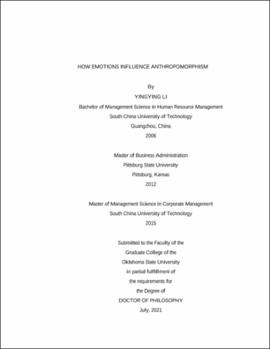| dc.contributor.advisor | Voss, Kevin E. | |
| dc.contributor.author | Li, Yingying | |
| dc.date.accessioned | 2022-01-09T19:44:13Z | |
| dc.date.available | 2022-01-09T19:44:13Z | |
| dc.date.issued | 2021-07 | |
| dc.identifier.uri | https://hdl.handle.net/11244/333652 | |
| dc.description.abstract | The purpose of this dissertation is to explore the relations between emotion, consumers anthropomorphism, and related consequences. Current literature examines this relationship by the perspective that anthropomorphic brand designs can elicit certain emotions and increase brand evaluations subsequently (Aggarwal and McGill 2007; Aggarwal and McGill 2012; Kim et al. 2016; Yuan and Dennis 2019). Minimal amount of research investigates this relationship from the direction that emotion can induce anthropomorphism. To fill this void, I examine the effect of emotional valence and arousal separately in this dissertation. It is valuable to scrutinize the effect of these two dimensions respectively (Di Muro and Murray 2012) since they are independent from each other. In fact, the results across six studies revealed that valence and arousal did not influence consumers' anthropomorphism in the same way. While the initial proposal was based on the suggestion that emotional arousal would influence anthropomorphism, my conclusion based on the studies reported herein is that both emotional arousal and emotional valence play a significant role. Positively valenced emotions tend to have significant effects in all three studies. Emotional arousal seems more complicated. I never observed a significant affect from the manipulation of emotional arousal to the dependent variables, however, measured felt arousal appears to be positively and significantly related to anthropomorphism. While I cannot claim that emotions drive anthropomorphism to the exclusion of cognitive operations, it is clear that emotions can play an important role in anthropomorphism. Additionally, study 3a and 3b suggest that compared with the brand with low preexisting anthropomorphism, likability to the brand with high preexisting anthropomorphism stays in a relatively high level regardless of consumers' emotion. Hence, I suggest that high preexisting anthropomorphism can be a buffer for a brand. | |
| dc.format | application/pdf | |
| dc.language | en_US | |
| dc.rights | Copyright is held by the author who has granted the Oklahoma State University Library the non-exclusive right to share this material in its institutional repository. Contact Digital Library Services at lib-dls@okstate.edu or 405-744-9161 for the permission policy on the use, reproduction or distribution of this material. | |
| dc.title | How emotions influence anthropomorphism | |
| dc.contributor.committeeMember | Arnold, Todd J. | |
| dc.contributor.committeeMember | Shepherd, Steven | |
| dc.contributor.committeeMember | Pappas, James M. | |
| osu.filename | Li_okstate_0664D_17248.pdf | |
| osu.accesstype | Open Access | |
| dc.type.genre | Dissertation | |
| dc.type.material | Text | |
| thesis.degree.discipline | Business Administration | |
| thesis.degree.grantor | Oklahoma State University | |
